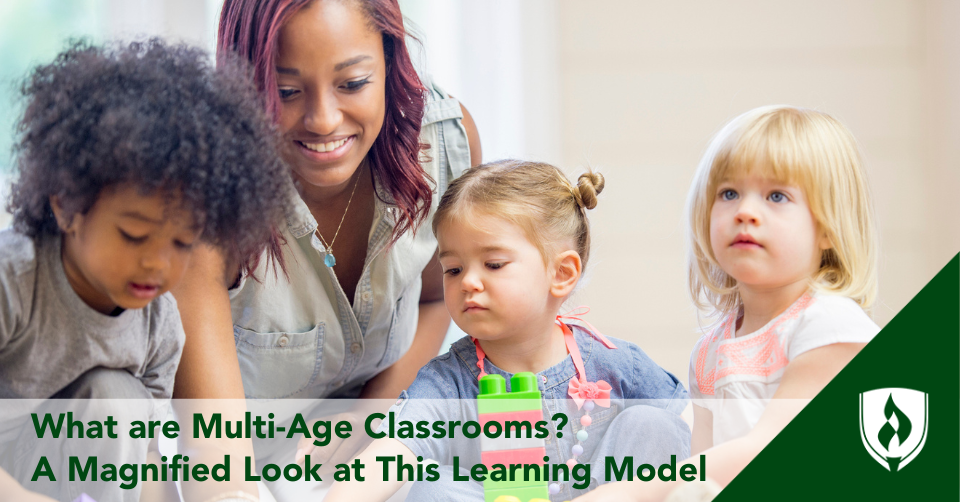What are Multi-Age Classrooms? A Magnified Look at This Learning Model
By Robbie Gould on 10/24/2023

When it comes to innovative educational practices, multi-age classrooms are near the top of the list. And for good reason.... These learning environments take advantage of a child’s innate fascination with other kids, both older and younger than they are, to amazing effect.
As you continue your journey into the world of early childhood education (ECE), learning about multi-age classrooms can highlight the elasticity of education. There’s always more than one way to do something when it comes to childhood learning.
Read on to gain a deeper understanding of this enriching educational approach and its significance in the field of early childhood education.
What is a multi-age classroom?
Multi-age classrooms are also known as a composite class, multi-grade or mixed-age classrooms. They represent a departure from the conventional age-segregated educational model that we've become accustomed to in the typical U.S. school system.
A multi-age classroom is an educational setting where students of different ages and grade levels learn together in a single classroom under the guidance of a teacher or a team of educators. In early childhood, many learning environments are already like this—mixing toddlers, infants and preschoolers together in the same play areas.
In mixed-age classes, children of varying ages collaborate, interact and learn from one another.
The main objectives of multiage classrooms, or composite classes, are to foster a sense of community, encourage cooperative learning and promote holistic development by embracing the natural diversity of children's abilities, skills and interests at different stages of their development.
Key characteristics of a multiage classroom
Age diversity
Students in a multi-age classroom can span multiple grade levels, often ranging from one to three years apart in age.1 For example, you may find younger children, aged 3 to 6, learning together in the same classroom.
Flexible groupings
Instruction and activities are organized based on skill levels and developmental readiness rather than strict grade levels. This flexibility allows educators to adapt to students' needs and interests more effectively.
Holistic learning
The approach in a multi-age classroom often emphasizes holistic learning, where academic subjects are integrated with social and emotional development, fostering a well-rounded education.
What type of schools use multi-age classes?
While it’s not the norm in all educational systems, multi-age classrooms have gained popularity for their potential to create a more inclusive and individualized learning experience that accommodates the diverse needs and abilities of students.
Montessori schools
Montessori education is known for its emphasis on mixed-age classrooms. In Montessori schools, children of different ages share the same learning space. Montessori schools often require their educators and instructors to take specific training to prepare them for this style of education.
This approach is based on the belief that it mirrors real-life social interactions where children learn from one another—a big emphasis in the Montessori philosophy.
Waldorf schools
Waldorf education often employs multi-age classrooms, where students stay with the same teacher for multiple years. This continuity allows for a deep teacher-student relationship and a better understanding of each child's developmental progress.
That continuity is key in Waldorf’s philosophy which emphasizes learning through play and tailored exploration.
Reggio Emilia-inspired programs
The Reggio Emilia® approach deeply values multi-age groupings, fostering flexible collaboration. This approach encourages children to explore their interests while engaging with peers across age ranges.
Nature-based or forest schools
Many nature-based or forest schools incorporate multi-age classrooms. These schools are all about natural environments and outdoor learning. What could be more natural than a community of children running through a field or climbing through a forest?
Private and independent schools
Many private and independent schools, inspired by various educational philosophies, adopt multi-age classrooms as part of their approach to education. These schools often emphasize personalized learning and holistic development.
International schools
Some international schools, especially those following alternative educational models, may incorporate multi-age classrooms to cater to a diverse student body from various cultural backgrounds.
Cooperative preschools
Cooperative preschools often use multi-age classrooms as they involve parents in the educational process. These settings promote a sense of community and shared responsibility among families.
What are the pros and cons of multi-age classes?
Multi-age classrooms offer unique advantages and challenges that should be considered when evaluating their effectiveness in an educational setting.2 Here are some of the pros and cons of multi-age classes:
Pros of multiage classes
- Individualized learning
Multi-age classrooms allow for personalized instruction tailored to each student's abilities, interests, and developmental stage. Teachers can adapt their teaching methods to better meet the diverse needs of their students. - Peer learning
Older children often act as mentors and role models for younger classmates, which can enhance learning through peer teaching. Younger students benefit from observing and learning from their older classmates. - Continuity
Students typically remain with the same teacher or in the same class for multiple years in a multi-age classroom. This continuity fosters strong teacher-student relationships and a deeper understanding of each child's learning style and needs. - Social and emotional development
Interacting with peers of different ages can contribute to social and emotional growth. Younger children learn valuable social skills from older peers, and older students develop empathy and leadership qualities. - Individualized instruction
Teachers can organize students into groups based on skill levels rather than strict grade levels, allowing for more flexible and effective instruction. This approach accommodates variations in academic readiness. - Reduced competition
Multi-age classrooms tend to reduce the emphasis on competition and grades. Students are less likely to compare themselves with peers solely based on age or grade, which can reduce stress and promote a positive learning environment. - Inclusivity
Multi-age classrooms can be more inclusive, as students with diverse abilities and learning styles can be accommodated within the same classroom. This promotes a sense of belonging for all students.
Cons of multi-age classes
- Curriculum challenges
Designing and implementing a curriculum that meets the needs of students across different age ranges can be challenging. Teachers must ensure that all students are appropriately challenged and supported. Educators in multi-age classrooms must be well-prepared to differentiate instruction effectively. Professional development and ongoing training are essential to support teachers in adapting to the diverse needs of their students. - Resource allocation
Multi-age classrooms may require additional resources, such as differentiated materials and teaching strategies, to address the varying abilities and needs of students. This can put a strain on limited educational resources. - Standardized testing
In systems that rely heavily on standardized testing, multi-age classrooms may face challenges in aligning their curriculum and assessment methods with grade-level expectations. - Transition challenges
Continuity is both a benefit and a challenge. When students move between multi-age classrooms or do need to transition to traditional grade-level settings, they may face adjustments in terms of academic expectations and peer interactions. - Potential for conflict
While a multi-age class can promote positive social interactions, they may also present opportunities for peer conflicts due to age differences or varying maturity levels. Teachers must be skilled in conflict resolution.
Embracing your students' development
The concept of multi-age classrooms has emerged as a progressive and dynamic approach to facilitating learning and development in young children. These classrooms represent an innovative and inclusive approach to education, offering a wide range of advantages for both younger and older students, like personalized learning, peer mentorship and social and emotional growth.
Supporting the diverse age range within these classrooms not only enriches each student’s educational experience, but also lays a solid foundation for lifelong learning and interpersonal relationships.
If you're ready to learn more about how you can support the development needs of your kiddos, read our article and learn from the pros, "Experts Explain How to Support Kids Through the Stages of Child Development."
Rasmussen University ECE programs do not prepare students for licensed teaching positions in any public school setting, but students will have the opportunity to help shape the futures of young children from birth to age six in a childcare and non-public school setting or leadership role.
Reggio Emilia® is a registered trademark of SCUOLE E NIDI D'INFANZIA -; ISTITUZIONE DEL COMUNE DI REGGIO EMILIA ENTE ITALY Via Guido da Castello 12 I-42121 Reggio Emilia (RE) ITALY
1D Braff. U.S. News and World Report. The Pros and Cons of Multiage Classrooms. Date accessed 9/13/2023. https://www.usnews.com/education/k12/articles/the-pros-and-cons-of-multiage-classrooms#:~:text=Often%20found%20in%20Montessori%20and,by%20ability%20in%20different%20subjects.
2R Strong, TE Spradlin, JA Plucker. Center for Evaluation and Education Policy. The Advantages and Disadvantages of Multiage Classrooms in the Era of NCLB Accountability. Date accessed 9/13/2023. https://files.eric.ed.gov/fulltext/ED504569.pdf




